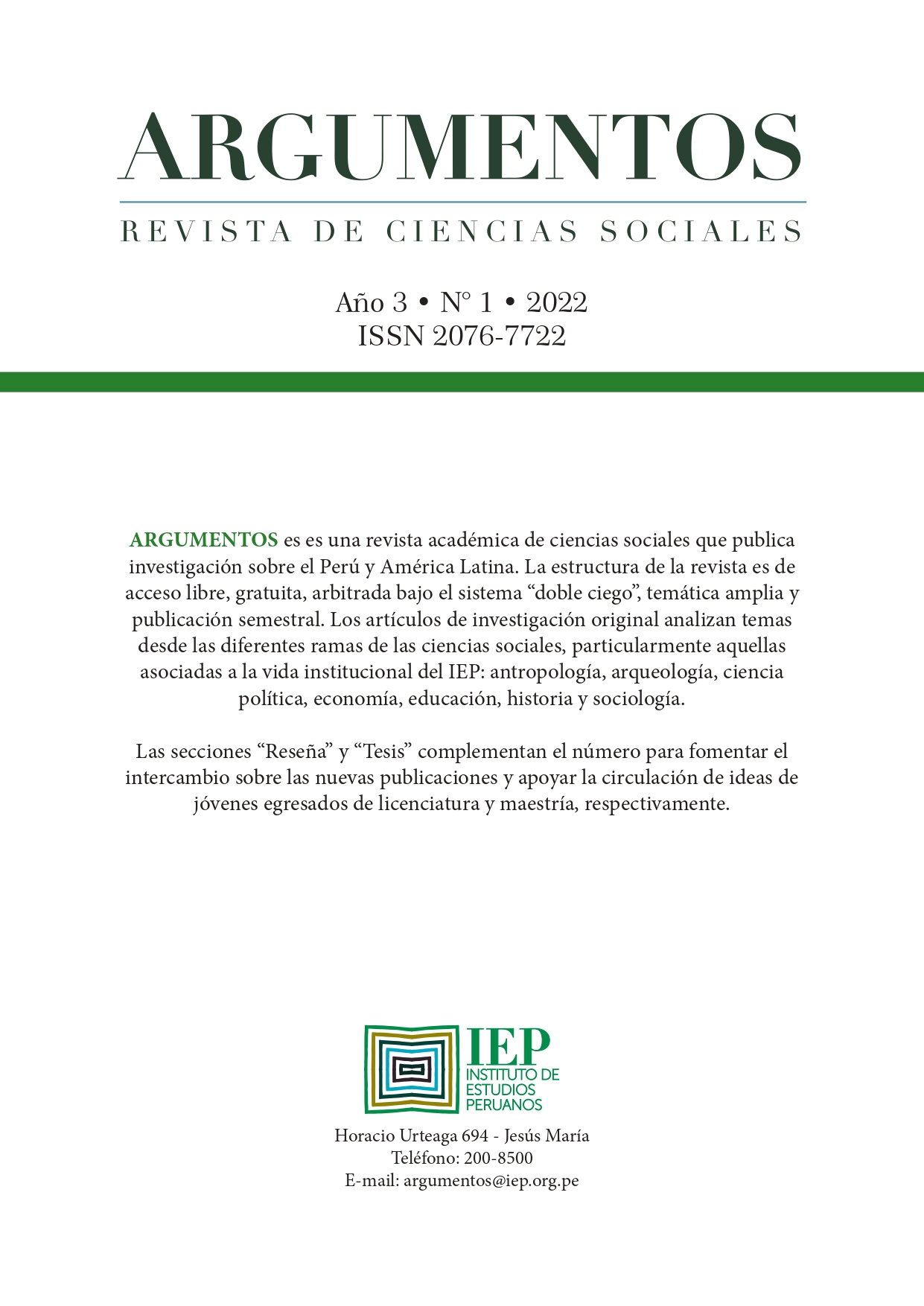Huanta, Pamplona, and Cobriza: three cases of repression during the military government of Velasco Alvarado (1968-1971)
Abstract
The government of Juan Velasco (1968-1975) is normally differentiated by its humanist and populist discourse among dictatorial experiences, where the doctrine of national security materialized in a repressive policy of persecution of the left. This article tries to study the concrete political struggles that the government had to face and the repression that it deployed to crush dissent, especially from the «far left». The objective of this article is to present three cases of repression: Huanta, Pamplona and Cobriza through the minutes of the council of ministers and the publications Oiga and Caretas; also, it analyzes the decision-making process and justification of state violence. This review will show that the government did not have a unitary idea about the use of repression, since the violence during this period followed a long-term pattern and, in this sense, repression finally prevailed as a habit and marked the conflictive relationship between teachers’ and miners’ unionism with the military government of Velasco.
References
Abad, A. (2021) Estado, capitalismo e inicios del problema de vivienda en Lima. La formación de Ciudad de Dios. Editorial Ande.
Aguilar, J. (2016). Choque de revolucionarios: Maoístas y militares durante la dictadura de Juan Velasco Alvarado en Perú. Istor: revista de historia internacional, 16(64), 35-64.
Artola, A. (1976) Subversión. s.f
Alburquerque, G. (2022). Militares de izquierda y Doctrina de Seguridad Nacional en Ecuador: el gobierno de Guillermo Rodríguez Lara, 1972-1976. Historia 396, 11(2), 3-32.
Alburquerque, G. (2017). No alineamiento, tercermundismo y seguridad en Perú: La política exterior del gobierno de Juan Velasco Alvarado (1968-1980). América Latina Hoy, 75, 149-166. https://doi.org/10.14201/alh201775149166
Baella, A. (1978) Secuestro. Ediciones El Tiempo.
Béjar, H. (2021). Velasco. Ediciones Achawata.
Caro, R. (1998) Vanguardia Revolucionaria: una introducción a los orígenes y desarrollo de la nueva izquierda peruana (1965-1972). Tesis de licenciatura en sociología en la PUCP.
Calla, J. (2010) Una experiencia de liderazgo democrático: Julio Pedro Armacanqui Flores. http://magisteriodigno.blogspot.com/2010/07/una-experiencia-de-liderazgo.html
Casals, M. (2020). Which borders have not yet been crossed? A supplement to Gilbert Joseph’s historiographical balance of the Latin American Cold War. Cold War History, 20(3), 367-372. https://doi.org/10.1080/14682745.2020.1762311
Chase, M. (2010). The Trials: Violence and Justice in the Aftermath of the Cuban Revolution en Grandin, G. y G. Joseph (Eds.) A Century of Revolution: Insurgent and Counterinsurgent Violence during Latin America´s Long Cold War. Duke https://doi.org/10.1215/9780822392859-006
Cockburn, J. (2016) La ciudad ilegal: Lima en el siglo XX. Punto Cardinal.
Collier, D. (1978). Barriadas y élites: De Odría a Velasco. IEP. https://repositorio.iep.org.pe/handle/IEP/693
Contreras Carranza, C. (2021). «Successes and Failures of the “Modern Rebellion” in an Export Economy: The Case of the Peruvian Mining in the Twentieth Century». En Peres-Cajías, J. Duncoing, C. (Eds.) Natural Resources and Divergence (pp. 67-112). Springer.
Degregori, C. I. (2014). El surgimiento de Sendero Luminoso: Ayacucho 1969-1979. IEP
Dorais, G. (2011). «Les Ennemis de Mes Ennemis Sont Mes Ennemis: Regard Sur L’émergence de la Gauche Radicale Péruvienne Dans la Foulée des Réformes Velasquistes (1969–1980)». Canadian Journal of Latin American and Caribbean Studies / Revue canadienne des études latino-américaines et caraïbes, 36(71), 197-233. https://doi.org/10.1080/08263663.2011.10817005
Escamilla, Y. (2019). El movimiento estudiantil de Huanta, un eco andino del 68. Escripta, 1(2), 2. http://escripta.uas.edu.mx/index.php/escripta/article/view/82
Esparza, M. (2009). «Introduction: Globalalizing Latin American studies of state violence and genocide» en Esparza, M Huttenbach, H; Feiesrstein. State violence and genocide in Latin America: The Cold War years. Routledge.
Galvez, A. y Portugal, C. (2021) Entre guerras: militancia y activismo sindical minero en las décadas 70 y 80. Fauno ediciones.
Gamarra, E. (2018) La Masacre de Cobriza. https://habemusdataperu.wordpress.com/2018/11/14/669/
Grandin, G. y G. Joseph (2010) A Century of Revolution: Insurgent and Counterinsurgent Violence during Latin America´s Long Cold War. Duke
Gyger, H. (2019) Improvised Cities: Architecture, Urbanization and Innovation in Peru. Pittsburgh
Krujit, D. y Vellinga, M. (1980) Las huelgas en la Cerro de Pasco Corporation (1902-1974): los factores internos. en Revista Mexicana de Sociología, Vol. 42, N.°4 https://doi.org/10.2307/3539962
Kruijt, D. (1983). Estado, clase obrera y empresa transnacional: El caso de la minería peruana, 1900-1980. Siglo XXI.
Kuramoto, J y Glave, M. «Extractivismo y Crecimiento Económico en el Perú, 1930-1980» en Contreras, C. La economía peruana entre la gran depresión y el reformismo militar. Banco Central de Reserva.
Lvovich, D. (2020) La violencia dictatorial y la violencia estatal de largo plazo en el Cono Sur de América Latina: entre lo excepcional y lo habitual en Historia: questoes e debates, 68 (1). http://dx.doi.org/10.5380/his.v68i1.69044
Lynch, N. (2021) La universidad y el poder en el Perú en los últimos cien años en Investigaciones Sociales, N.° 44. https://doi.org/10.15381/is.v0i44.19571
McSherry, P. (2009) «Industrial repression and Operation Condor in Latin America» en Esparza, M Huttenbach, H; Feiesrstein, D. State Violence and Genocide in Latin America. Routledge
Méndez, C. (2021). The Paths of Terrorism in Peru: Nineteenth to Twenty-First Centuries* en R. English (Ed.), The Cambridge History of Terrorism (pp. 420-452). Cambridge University Press. https://doi.org/10.1017/9781108556248.017
Mercado Jarrin Edgardo. (1974). Seguridad, Politica Y Estrategia (2a ed.). Ejército del Perú.
Medina, J. (2019) «Desencuentros por la izquierda durante el velasquismo. La matanza de Cobriza». Revista Argumentos. N°2, año 13. https://argumentos-historico.iep.org.pe/articulos/desencRuentros-la-izquierda-velasquismo-la-matanza-cobriza/
Meza, M. (2020) «La Nueva Izquierda y la competencia por la revolución en el Perú durante el gobierno de Velasco, 1968-1975» en Izquierdas, N.° 49.
Monsalve, M. y Puerta, A. (2021) «From Business Associations to Business Groups: Business-Government Relations and Corporate Networks During the Military Dictatorship, Peru 1968-1980» en Basualdo, V; Berghoff, H y Bucheli, M. (Eds.) Big Business and Dictatorships in Latin America: A Transnational History of Profits and Repression. Palgrave MacMillan
Mucha, A. (director) (2019) La herencia de Huanta. https://www.youtube.com/watch?v=G54ssAxN41U&t=12s
Pettina, V. (2018). Historia mínima de la Guerra Fría en América Latina. El Colegio de México.
Pontoriero, E. D. (2016). De la Guerra (contrainsurgente): la formación de la doctrina antisubversiva del Ejército argentino (1944-1976) en Águila, G; Garaño, S. y Scatizza, P. (Eds.) Represión estatal y violencia paraestatal en la historia reciente de Argentina. Nuevos abordajes a 40 años del golpe de estado. Universidad Nacional de La Plata. https://ri.conicet.gov.ar/handle/11336/106010
Ramírez, J. D. (2014). Movimiento sacerdotal ONIS: La iglesia en el Perú ante las demandas de justicia social 1968-1875. Seminario de Historia Rural Andina: Fondo Editorial Universidad Nacional Mayor de San Marcos.
Rodriguez, J. (1983). Los militares y el poder. Un ensayo sobre la doctrina militar en el Perú: 1948-1968. Mosca Azul Editores.
Stiglich, M., & Lerner, A. (2019). Informal Urbanization and the State–The Rise and Fall of Urban Populism in Lima. En Rocco, R. y van Ballegooijen, J. (Eds.) The Routledge Handbook on Informal Urbization.
Saldaña, J. Y Portocarrero, J. (2017) La violencia de las leyes: el uso de la fuerza y la criminalización de las protestas socioambientales en el Perú en Derecho (PUCP), N.° 79. http://dx.doi.org/10.18800/derechopucp.201702.013.
Sánchez, J. (2002) La Revolución Peruana: ideología y práctica de un gobierno militar, 1968-1975. Universidad de Sevilla.
Tello, M. (1983) Golpe o Revolución: hablan los militares del 68. SAGSA.
Toche, E. (2008). Guerra y democracia: Los militares peruanos y la construcción nacional (1. ed). Consejo Latinoamericano de Ciencias Sociales, CLACSO : Centro de Estudios y Promoción del Desarrollo, DESCO.
Ugarteche, O. (2019) Modernización reformista y deuda externa en el Perú, 1963-1976. IEP
Villanueva, V. (1982). Peru’s «New» Military Professionalism: The Failure of the Technocratic Approach. En Gorman, S. (Ed.) Post-Revolutionary Peru. Routledge.
Zapata, A. y Garfias, M. (2014) Apuntes de una historia de organización y lucha. FNTMSP.
Zapata, A. (2018) La Caída de Velasco: lucha política y crisis del régimen. Taurus.
Zapata, A. (2021) Lucha política y crisis social en el Perú Republicano, 1821-2021. PUCP.
Zolov, E. (2014) Introduction: Latin America in the Global Sixties en The Americas, 70(3). https://doi.org/10.1017/S0003161500003953
Copyright (c) 2022 Alejandro Santistevan

This work is licensed under a Creative Commons Attribution 4.0 International License.








